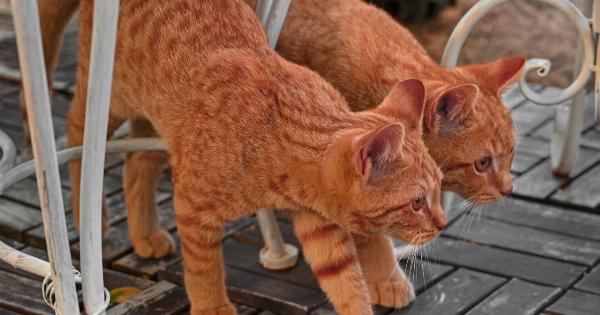When it comes to pets, cats often stand out for their mysterious and enigmatic behavior. They have a reputation for being independent, aloof, and even a bit unpredictable.
Cat owners can attest to the fact that they often exhibit peculiar habits and tendencies that can leave us scratching our heads in wonder. In this article, we will explore some of the fascinating and puzzling behaviors of cats, delving into their mysterious ways.
1. Purring: A Source of Mystery
One of the most iconic and intriguing behaviors of cats is their ability to purr.
It’s no secret that cats purr when they are content and relaxed, but did you know that they also purr when they are anxious or in pain? The exact reason behind this behavior is still unknown to researchers, making it a fascinating mystery. Some theories suggest that purring serves as a soothing mechanism, while others speculate that it has healing properties. Regardless of the scientific explanation, the sound of a purring cat is undeniably comforting to many cat owners.
2. The “Silent Meow”
We all know that cats meow to communicate with humans, but have you ever noticed that sometimes they seem to meow without making any sound? This phenomenon is known as the “silent meow,” and it adds to the enigmatic nature of cats.
Some cats may open their mouths as if they are meowing but produce no sound. While the exact reason for this behavior is unknown, it is often believed that cats use the silent meow as a way to manipulate humans, playing on our natural inclination to respond to their vocalizations.
3. Kneading: A Remnant of Kittenhood
If you’ve ever had a cat knead on you, you may have wondered why they engage in this peculiar behavior. Kneading is when a cat rhythmically pushes their paws in and out against a surface, often accompanied by purring.
This behavior is reminiscent of the kneading motion kittens make while nursing, as it stimulates milk flow from their mother. Therefore, it is believed that adult cats retain this behavior as a way to find comfort and security, akin to a nostalgic reminder of their early days.
4. The Infamous “Zoomies”
Anyone who has ever shared a home with a cat is familiar with the phenomenon of the “zoomies.” This term describes the sudden burst of energy cats often display, generally characterized by frantic running, jumping, and playful antics.
The exact reason behind the zoomies is unclear, but it is commonly attributed to cats’ natural predatory instincts. It is believed that cats release pent-up energy through this behavior, mimicking their hunting and stalking skills. The zoomies can strike at any time, leaving both cats and their owners puzzled but entertained.
5. The Fascination with Boxes
One of the simplest yet most mysterious behaviors of cats is their obsession with boxes. Regardless of their size or age, cats seem to have an innate attraction to any box within their vicinity.
It is believed that boxes provide cats with a sense of security and comfort as they mimic small, enclosed spaces similar to their natural hiding spots in the wild. Boxes also give cats a vantage point from which they can observe the world around them without feeling exposed.
So, the next time you see your furry friend lounging in a cardboard box, remember that it’s not just a box to them – it’s a fortress.
6. The Curious Love-Hate Relationship with Water
Most people are familiar with the generalization that cats despise water. While this holds true for many cats, there are some feline friends who display an unusual affinity for water.
Some cats may voluntarily dip their paws in water bowls or even join their owners in the shower. This peculiar behavior has intrigued scientists for years.
One theory suggests that cats enjoy the cooling sensation of water on their paws during hot weather, while another proposes that it could be a genetic trait inherited from their wild ancestors, who needed to swim to catch prey.
7. The Inscrutable Stare
There is an old saying that eyes are the windows to the soul, and this rings particularly true when it comes to cats. Cat owners often find themselves captivated by the intense, inscrutable stare of their feline companions.
Cats have a unique ability to hold eye contact, gazing deeply into our souls. This behavior can be seen as a sign of trust and affection, as cats reserve this level of eye contact for individuals they feel comfortable with.
It is also worth mentioning that in the feline world, prolonged eye contact is a sign of challenge or dominance, so it is important to interpret this behavior in the context of your cat’s overall body language.
8. Nighttime Shenanigans
Many cat owners have experienced the perplexing scenario of their furry friend transforming into a nocturnal party animal.
While cats are crepuscular by nature (more active at dawn and dusk), they often become particularly rambunctious during the late hours of the night. This behavior can be attributed to their natural hunting instincts, which are triggered by the reduced activity and quietness at night.
Cats may engage in playful behavior, exhibit bursts of energy, or even vocalize more frequently during these nighttime escapades. While it may disrupt our sleep, witnessing our cats’ mischievous side in the darkness adds another layer to their mysterious ways.
9. Temperamental Preferences
Cats have a reputation for being independent, and this characteristic extends to their preferences for human interaction. Some cats may crave attention and affection, seeking out their owners’ company and demanding cuddles at every opportunity.
On the other hand, some cats display more aloof behavior, seeming to prefer solitude over constant human companionship. This individuality and temperamental diversity make understanding cats even more perplexing. Just like humans, each cat has its personality and unique preferences, adding to the enigma surrounding their behavior.
10. The Peculiar Sensitivity to Sound
Have you ever noticed your cat’s ears twitching or pricking up at certain sounds that are almost inaudible to humans? Cats have extraordinary hearing abilities, surpassing those of humans or most other mammals.
They can detect frequencies far beyond our auditory range and are incredibly sensitive to even the slightest sounds. This keen sense of hearing is a result of their evolution as predatory animals, enabling them to hone in on potential prey or detect potential threats.
So, the next time you see your cat react to a faint sound that seems imperceptible to you, remember their exceptional auditory capabilities.






























